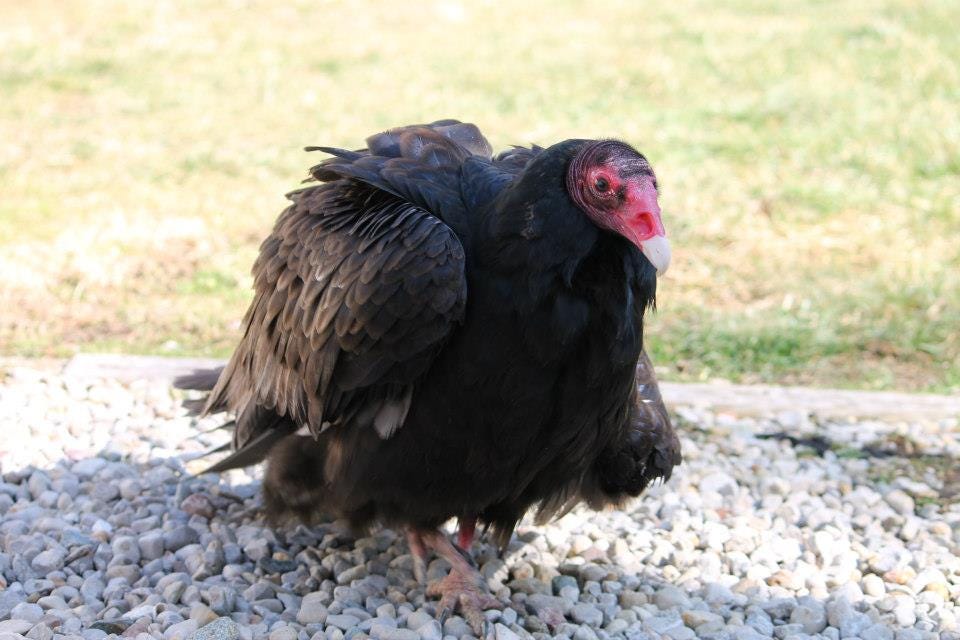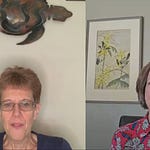Send me your beloved animals names for my free long-distance healing and blessing of the Animals. Share in comments or message me: include your animal friends name, your healing ‘ask’, and send photos, permissions for services and photo permissions. I may write about this free service and post on September 11th. And, thanks for your comments, shares and interest in last Wednesday’s Wildlands Regeneration Nation Challenge. There’s still time to join the challenge to increase health, well-being and connection with nature. You will have my personal guidance, as well as others supporting your journey. Details to follow after confirmation of paid subscription. Thank you for your paid subscriptions- 20% goes to growing organic gardens in schools and helping animals!
Today’s wisdom: “Nature does not hurry, yet everything is accomplished.” - Lao Tzu
Nature speaks, are you paying attention?
In death, I imagine our souls fly like winged ones…”free as a bird”. And, our cosmic flight unites us with everything, everywhere, at the same time—our “soul” is Omnipotent and Omniscient. Oneness… At-One-Ment. Limitless with the All That Is.
I’ve learned a lot from nature, about living “freely” through collaboration and Self-Reliance. I have journeyed the road less traveled with the intention of “flying while living”. My name is Robin, you know… Loud Hawk, A Poet with a Purpose.
If we allow them, nature and wildlife teaches us about life,: trauma, healing and resilience. Humans are ruff on animals and nature. Humans are also hard on other humans and themselves sometimes. Well, my friends, we get injured, animals get injured…many times through no fault of our own, at least in the case of wildlife. Wildlife are misunderstood, abused, exhausted, frightened and disregarded. They are thrown into a foreign, harsh world whether they know what hit them or not. Literally, many of wildlife’s accidents happen with vehicles and “economic development”. Even worse, they aren’t heard or seen, meaning, they are disrespected and unknown to many people. One time, a citizen brought a baby hummingbird to the wildlife rescue-rehab-release center because she was worried that the work she was having done on her back patio might disturb them, and they might get hurt. She was feeding a tiny baby hummingbird cold cuts, i.e., processed turkey. Ed says it’s not cool to be a wildlife fool. The best chance of survival for baby animals is with their mothers. Native habitats work well for them, too, especially undisturbed ones. In our current systems, they are strangers in their own home.
They may have lost their whole family, friends, support system, and familiar territory. Maybe they are even lost—like the seabirds who get blown into the Desert during storms. (Yes, this happens.) While working at a wildlife center, one volunteer drove a Pelican from the Desert to the Sea. With a veterinarian, she drove him to a wildlife vet, then the Pelican was released back into the wild.
Sometimes after flying thousands of miles to their seasonal home, wildlife find their home wiped out, after they struggled to get there. Hurricane Human strikes again.
Their water is poisoned, their homes and sustenance are scarce.
Sound familiar? Humans and animals are not that different. The good news? YOU can help them in many ways! Grow native wildflower habitats and woodlands instead of “green carpets.” Grow edible forests for wildlife and you.
Once a week, on Thursday, I help care for wildlife at a Nature Center, during what I affectionately call “Turdsday”. Besides cleaning up the doo, my duties include: providing fresh water and food for mammals, raptors, reptiles, rodents, snakes, and frogs.
While I hose out indoor and outdoor raptor enclosures, it’s not long before Ed, the Turkey Vulture, bashfully stops by to say hello and makes sure all is well. I say, “good morning, Ed, it’s fabulous to see you.” He may stretch, then with his wings tucked in to his sides, he turns and walks away slowly. He is a “free range” resident within the large enclosed area and his indoor lair will be cleaned soon. He’s sweet and gentle, except when he is near Rose, the Red-tailed Hawk, legend has it.
Turkey Vultures are larger than other raptors, except eagles and condors. They have long "fingers" at their wingtips and long tails that extend past their toes. When soaring, Turkey Vultures hold their wings slightly raised, making a ‘V’.
Turkey Vultures appear black from a distance but up close are dark brown with a featherless red head, and pale bill. Paler brown, grey, and white adorn the underside of their flight feathers. Their wingspan is 66.9-70.1 inches (170-178 cm).
Turkey Vultures are majestic in flight, with very few wingbeats. Look for them gliding, sniffing for carrion, or riding thermals up to higher vantage points. “They may soar in small groups and roost in larger numbers. You may also see them on the ground in small groups, cleaning up roadkill or dumpsters.”
By the way, Ed wanted me to tell you that vultures “circle” in air thermals and it’s a myth that they circle the dead. You would fly and play in air drafts, too, if you were a winged one. It’s fun. Ed misses those days…
I was writing about my wildlife adventures when appropriately named, Flight School’s asked, “what do you do when you are not writing?”
I wish I could show you the joy of wildlife bathing and showering. It’s a humid, 90 degree August afternoon. Rose, the Red-tailed Hawk, loves water and I love providing a shower and bath for her. I especially enjoy observing her joy and trust. We are becoming fast friends.
With a permanent shoulder injury, balance is challenging for her. Rose sits on the ground in the shady corner of her enclosure a lot, especially when it’s hot.
Not long after I arrive, she excitedly hops onto the thick edge and then into her large, clean bowl. She starts rolling in the water, picking up the water with her head and letting the water roll down her back. I can feel her relief and pleasure and it makes me happy.
After Rose has satisfied her bathing needs, she stands in her bowl and turns her back to me. I do my best to steady the spray as I hold a slender brass hose nozzle with my thumb to create a shower for her. It’s awkward to keep a consistent spray, but she doesn’t mind. She’s delighted to have a willing attendant.
I leave her cool, happy and standing on a large branch, clean and proud. So, pay attention to what nature is saying to you, be kind to the critters, and give back to others daily, my friends.
On Thursdays…Turdsdays, I will be showering Rose and other critters with water and love.
Hawk Facts
According to Cornell Labs, All About Birds, Red-tail hawks are the most common hawk in North America, with a wingspan of 3 ft 5 in to 4 ft 8 in (105-141 cm). The biggest females weigh about 3 pounds (1360 grams). Females are larger than males.
Red-tailed Hawks have been seen hunting as a pair, guarding opposite sides of the same tree to catch squirrels. It’s very rare for a Red-tailed Hawk to go after dogs or cats.
The oldest known wild Red-tailed Hawk was at least 30 years, 8 months old when it was found in Michigan in 2011, the same State where it had been banded in 1981.
Adult Red-tailed Hawks “make a hoarse, screaming kee-eeeee-arr, for 2-3 seconds and is usually given while soaring. During courtship, they also make a shrill chwirk, sometimes giving several of these calls in a row.” In television and film, Red-tail Hawk calls are used for the Eagle’s call.
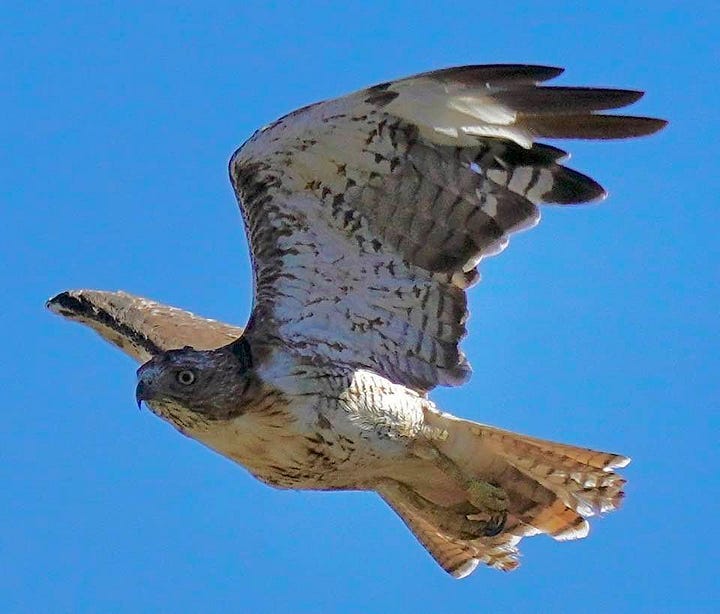
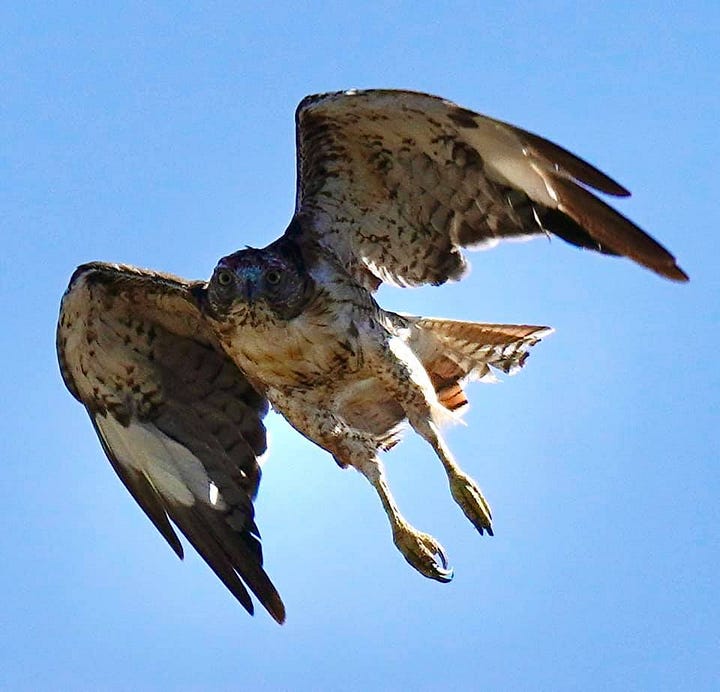
Do you love flora, fauna, resonate with the biota, and perhaps, do you love hawks? Biophilia is “the passionate love of life and of all that is alive.” Nature speaks through the seasons, soils, souls of the critter calls and their pleas…
I’ve worked with wildlife for many years, and have worked at two wildlife centers with dozens of species in the Desert and in the Midwest. Read about my Mowgli-like ability to talk with the animals. I have stories with bear; fish; birds and hawks, butterflies, and bees. I also work with domestic and farm animals. Learn about flora and nutrition- Wildlands essays are packed with information and some simple recipes for you.
By the way, the wildlife wanted me to tell you that they are not that different than humans. They have friends, families, feelings, needs, habits, personalities, purpose and intelligence. They don’t “poop in their own nest”, like humans do, so, that may make them smarter than humans. (Ed and Rose did not say that some humans are dumb and destroy instead of collaborate, Robin did).
Share Wildlands with your friends who want to grow and help make the world a better home for self and others. Religious and Spiritual teachings share many various themes regarding ‘treat others as you wish to be treated’. And, many also teach, you’ll “fly when you die.” Remember, you can fly while alive. We can choose to live in and create “paradise” while we are alive…to do so, you’ll need essential wisdom and good habits.
Wildlands mission is to teach and inspire behavioral change through word play, art, nature, health, well-being, connection, advocacy, fun and facts. I love healing people naturally, and I am good at it. I promise you, Wildlands will cheer you up and empower you.
The “poop” is this, my friends: Fly while alive—empower self, others, nature and animals, too! This is the moral and ethical choice, my friends! This is freedom- your piece of the peace! Respect and reciprocate, that is each of our purpose. Current and future generations will thank you, and life will be more in-joy-able, peaceful and prosperous for All.


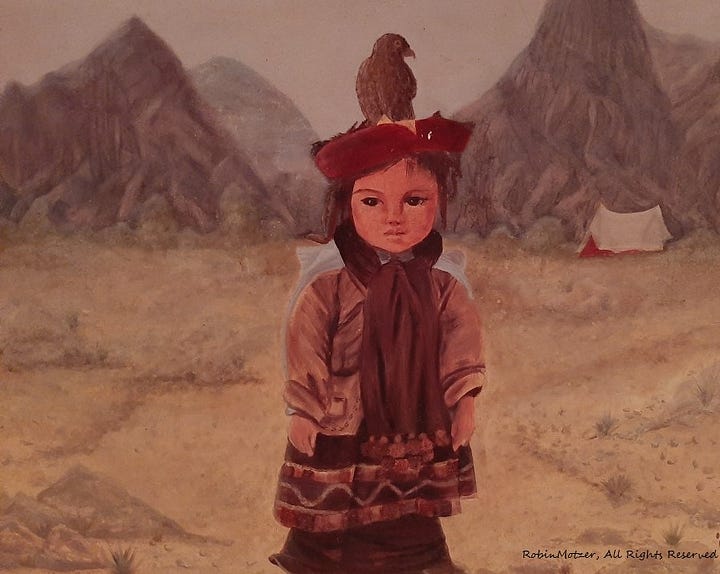
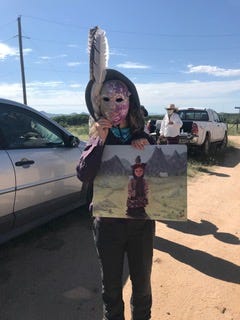
Love my work? Subcribe and Buy My Art: 20% of your financial support goes to school gardens.
Thank you for your support, dear friends and family! Drawing and painting are also what I do when I am not writing or with wildlife.
My art has been in local, National and International shows every month this year! My first art show award came from the Uncle Al Show when I was 3 years old, and I did not participate in another art show until my 40's. No, I wasn’t traumatized. It was a wonderful experience. And, I was on his show, among others, too. To be candid with you, I have been an artist and a writer (and animal-nature lover) all my life, and they are gifts from God, or whatever name is meaningful to you. I have been shy about my art and my writing, as it is a special bond between Creator and me that no job could ever match. Thank you for supporting my calling to help Life Thrive, Regeneration Nation, in Wildlands and Habitat Restoration.
My art, 'Water at Sunset' is now being showcased at Aesthetics - 2024 exhibition, organized by Gallerium and powered by @Biafarin platform.
To learn more, please visit:
Water at Sunset, by Robin Motzer;
Meadow, in Kingdom Animalia exhibition;
Starry Night, in Gallerium Art Show;
Earth Healing in Creative Minds Art Show;
Forest Blue, in Colorium Art Show; and,
Forest Blue, page 67, in Artstonish Art Show.
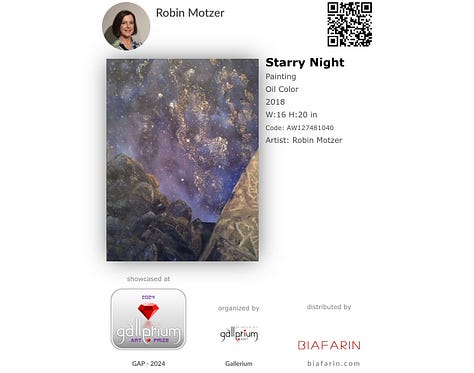
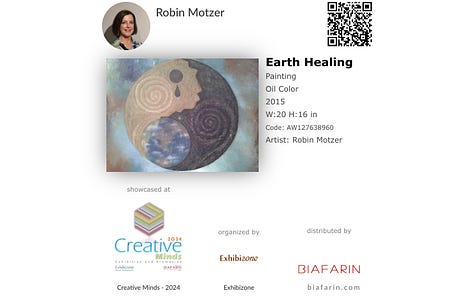


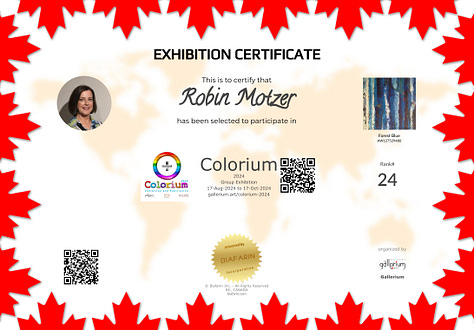
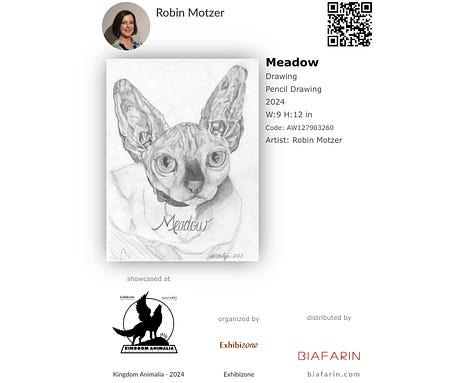
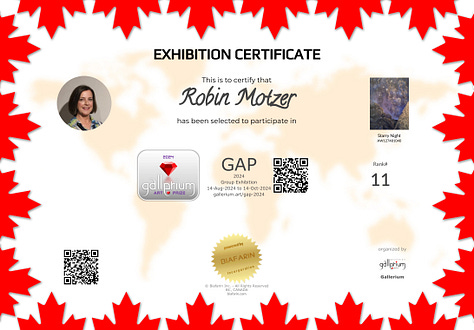
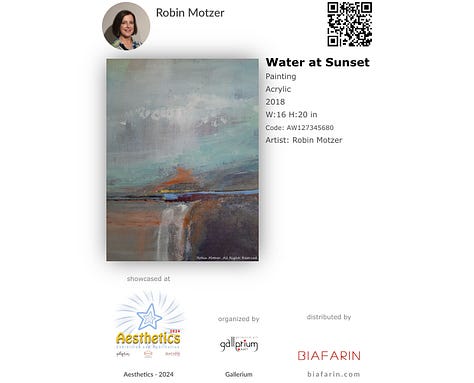
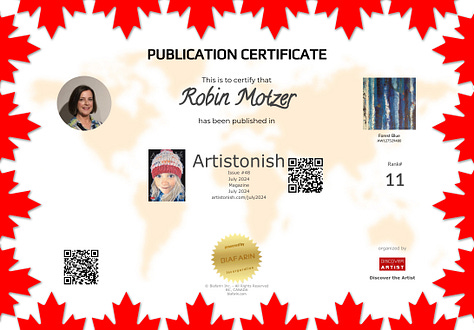
Subscribe to Wildlands to learn how to be healthy, simply, with what’s good, right and true. From One who has flown healthy and free for decades, I’ll show you how your mind-body-spirit can have well-being, too. Let’s explore new frontiers together.
Learn how to expand your audience. You can be in the news, in online and print magazines.
Meet trailblazers, and learn about the biota! Print and Audio available.
Read my hawk essay in Outdoor Magazine!
Learn about healing with food, and please subscribe to Wildlands.
Talent shout out, check them out:
Here are some more fine photographers and writers I’ve been enjoying, and I think you will, too:
- Jon Norris Photo- his dazzling nature photos resonate with work, and my paintings. - From the Corner of My Mind, sharing her perspective. -Conservation writer.Other Ways to Support Wildlands:
Giveback Stack: 20% goes to school gardens!




